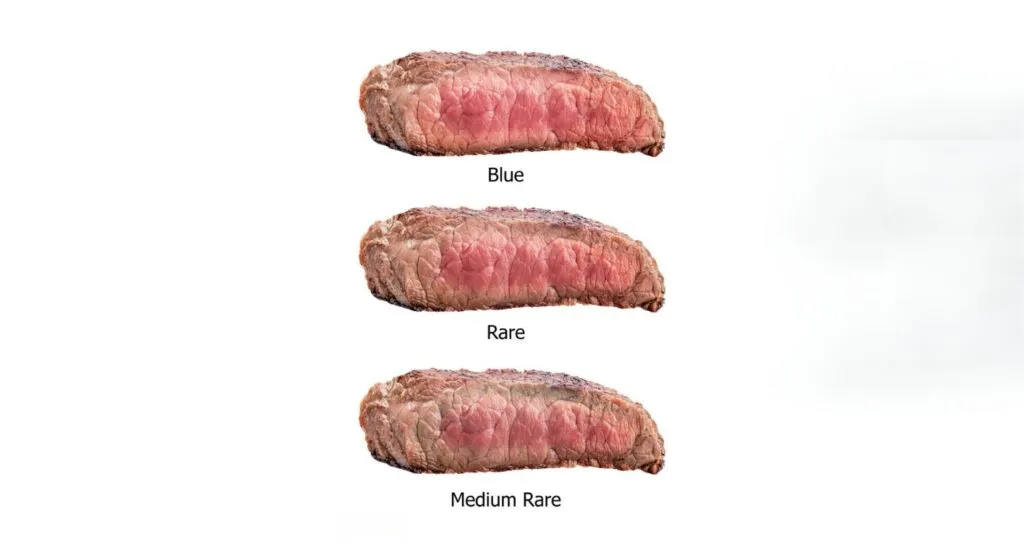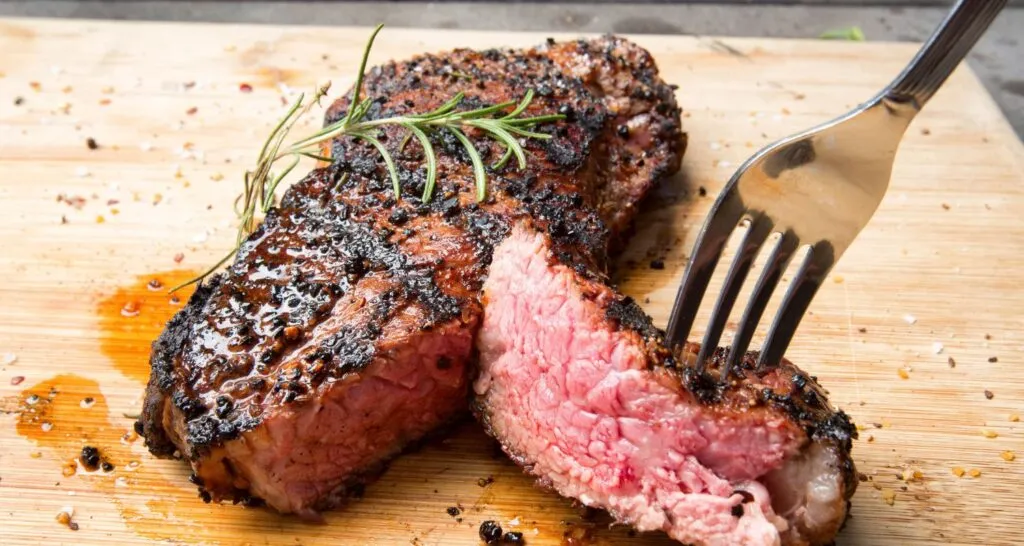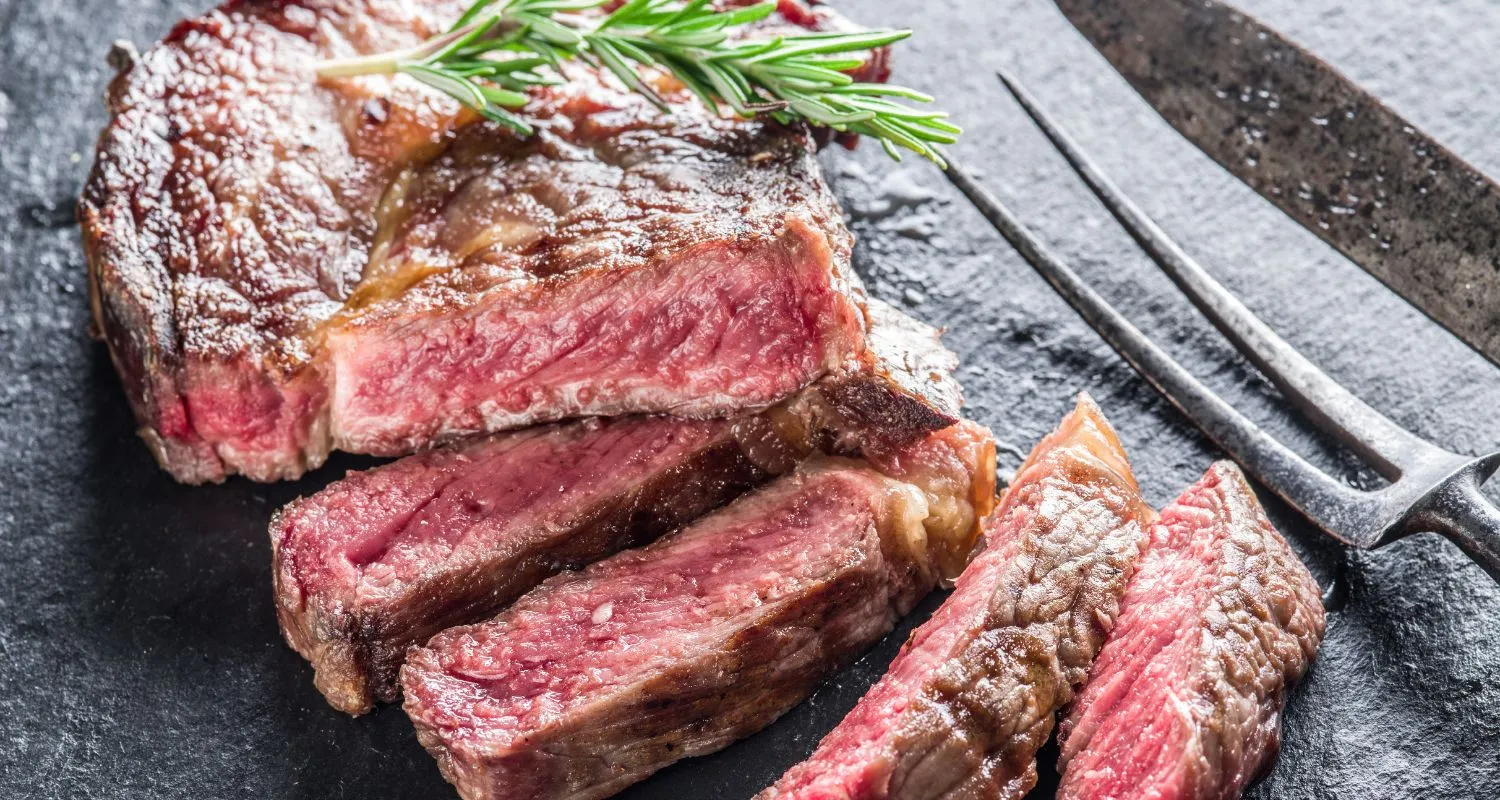In the culinary world, the quest for the perfect steak takes us on a journey through various cooking techniques, cuts, and flavors. Among these, blue steak stands out as a delicacy that intrigues and divides food enthusiasts. This article delves into the essence of blue steak, from selecting the right cut to cooking it to perfection, ensuring safety, and serving it with style. We’ll explore the nuances that make blue steak a unique culinary experience, answering common questions and debunking myths along the way. So, let’s embark on this flavorful adventure, ensuring every bite is a testament to the art of steak preparation.
Introduction to Blue Steak
What is Blue Steak?
Blue steak, often hailed as the pinnacle of steak cooking for the true connoisseur, is more than just a piece of meat; it’s an experience. Cooked very briefly, a blue steak is seared on the outside, leaving the inside soft, tender, and basically raw. This method highlights the meat’s natural flavors, making it a favorite among steak purists.

The Culinary Appeal of Blue Steak
The allure of blue steak is rooted in its straightforward approach and the expertise it demands for preparation. It transcends mere heating techniques, delving into the nuances of the meat’s texture and quality, and how these aspects interact with extremely brief cooking periods. This dish caters to those with a deep appreciation for culinary artistry and the robust, natural flavors of premium beef.
As we navigate the realm of blue steak, we’ll explore select cuts ideal for this method, along with essential safety tips, cooking strategies, and the art of pairing. This exploration is designed not just for the experienced chef but also for the culinary enthusiast eager to enhance their kitchen skills. Join us as we unveil the techniques to perfecting this exquisite steak, promising a gastronomic experience that enriches your cooking journey.
Preparing Blue Steak
Best Cuts for Blue Steak
When it comes to blue steak, not all cuts make the cut. The best options are those that are lean and tender, capable of being enjoyed with minimal cooking. Sirloin tip, top sirloin, round steak, flat iron, and filet mignon stand out as prime candidates. These cuts combine the perfect texture with the right amount of fat, ensuring a melt-in-your-mouth experience that’s hard to beat.
What Makes a Cut Suitable for Blue Steak?
A cut suitable for blue steak boasts a fine balance. It must be tender enough to eat almost raw yet flavorful enough to stand up to the high heat required for searing. The mentioned cuts excel in these areas, providing a foundation for a steak that’s unparalleled in taste and texture.
Safety Considerations
Is blue steak safe to eat? This question often lingers in the minds of many. The answer lies in the quality of the meat and the preparation process. Ensuring your steak is fresh and from a reputable source is paramount. Additionally, searing the outside kills surface bacteria, making it safe to enjoy the steak’s interior in its nearly raw state.
Tips for Ensuring Safety
- Always choose high-quality, fresh meat from trusted butchers.
- Ensure your cooking surface is extremely hot before searing.
- Keep cooking utensils and plates clean to avoid cross-contamination.
By adhering to these guidelines, you can enjoy blue steak without worry, savoring the delicate flavors and textures that make this dish a culinary treasure. In the next section, we’ll dive into the cooking techniques that bring out the best in your chosen cut, ensuring every bite is a celebration of quality and craftsmanship.
Cooking Techniques
Preparing Your Steak
Before you even think about turning on the stove, your steak requires a bit of TLC. First, let it reach room temperature. This step is crucial for ensuring even cooking. Next, pat it dry. Moisture is the enemy of a good sear, so make sure your steak is as dry as a bone. A light seasoning with salt can enhance the meat’s natural flavors, but remember, the star here is the steak itself.

Cooking Methods
The key to a perfect blue steak lies in the cooking method. High heat and speed are your best friends here.
Pan-Searing
Heat a skillet until it’s smoking hot. Literally. Add a touch of oil, then place your steak in the pan. Sear each side for just a minute or two. You’re looking for a beautiful crust with a basically raw interior. Remember, the steak will continue to cook slightly after it’s removed from the heat, so err on the side of caution.
Grilling
For those who prefer the grill, the rules are the same: hot and fast. Ensure your grill grates are clean and hot. A quick sear on each side will impart a delightful char and smoky flavor that complements the tender interior of the steak.
Testing for Doneness
The best tool for testing the doneness of a blue steak? Your instincts. Given the minimal cooking time, a meat thermometer won’t be much help. Instead, look for a crisp exterior and trust that the inside remains as tender and juicy as nature intended.
Cooking blue steak is an art that balances high heat with the briefest of cooking times to achieve perfection. It’s a testament to the beauty of simplicity in the culinary world, where the quality of the ingredient takes center stage. In the next section, we’ll explore how to serve and pair your blue steak, turning a simple meal into an unforgettable dining experience.
Serving and Pairing
Accompaniments for Blue Steak
A blue steak, with its rich and tender flavor, pairs beautifully with sides that complement rather than overshadow. Think light, think fresh. A crisp salad, some steamed greens, or a side of sautéed mushrooms can elevate your steak without stealing the show. Remember, the steak is the star here, and everything else is a supporting actor.
Wine Pairing
Choosing the right wine can turn a great steak into an extraordinary meal. For blue steak, you want a wine that can stand up to the robust flavors without overwhelming them. A bold red, such as a Cabernet Sauvignon or a Syrah, works wonders, offering a balance of fruit, tannin, and acidity that harmonizes with the steak’s richness. For more detailed guidance, consider exploring Wine Pairing Guide, which offers insights into selecting the perfect wine for every dish.
Exploring Flavors
Seasoning and Marinades
While the natural flavor of the steak should be at the forefront, a little seasoning can enhance rather than mask. A sprinkle of sea salt, a touch of pepper, or a simple marinade can add dimensions to the steak’s flavor profile without overwhelming it.
The Taste Experience
Eating blue steak is about savoring the purity and quality of the meat. Each bite should be a journey through textures and flavors, from the seared exterior to the tender, almost raw center. It’s a culinary adventure that celebrates the essence of steak.
Serving blue steak is an art that combines simplicity with sophistication. The right accompaniments, a thoughtful wine pairing, and a careful approach to seasoning can transform your steak into a meal that’s memorable for all the right reasons. In the next section, we’ll address some frequently asked questions about blue steak, demystifying this culinary delight and ensuring you’re equipped to enjoy it to its fullest.
FAQs
What is the difference between blue steak and rare steak?
Blue steak and rare steak are often mistaken for one another, yet a distinct line divides them. The former is quickly seared on the outside, maintaining a cool, mostly raw interior. Rare steak, conversely, undergoes a slightly longer cooking process, achieving a warm, lightly cooked center. The primary distinction rests in the internal temperature and texture—blue steak provides an unmatched tenderness.
How do I know when a blue steak is perfectly cooked?
Perfecting a blue steak is more art than science. Since it’s cooked for such a short time, using a meat thermometer isn’t practical. Instead, focus on the sear. The exterior should have a rich, caramelized crust, while the interior remains tender and cool. Trust your senses—sight, touch, and timing are your guides.
Can any steak be cooked to blue?
While technically any steak can be cooked to blue, not all cuts will offer a pleasant eating experience when prepared this way. The best cuts for blue steak are tender and lean, like filet mignon or top sirloin. These cuts provide the ideal texture and flavor when lightly seared and left mostly raw inside.
Is it OK to eat blue steak?
Indeed, eating blue steak is considered safe for most people, provided it’s prepared correctly. The outer surface of the steak should be seared at a high temperature to kill off surface bacteria. However, it’s important to source high-quality meat from reputable suppliers to minimize health risks.
What is a blue steak vs rare steak?
Comparatively, a blue steak is cooked very briefly, leaving it almost completely raw inside, with a cool center. On the other hand, a rare steak is cooked slightly longer, resulting in a warm, red center. Both are seared on the outside, but blue steak is more undercooked than rare.
Does blue rare steak have blood?
Contrary to popular belief, the red liquid in a blue rare steak isn’t blood but myoglobin, a protein that stores oxygen in muscle cells. Myoglobin, mixed with water, gives the impression of blood, especially in less cooked steaks.
How rare is blue rare?
Blue rare steaks are among the least cooked options available, only seared on the outside for a very short time, leaving the inside almost entirely raw. This level of doneness is quite rare in both preparation and preference, catering to those who enjoy the natural flavors of meat.
What steak is best rare?
Tender cuts such as filet mignon, ribeye, and sirloin are best suited for cooking rare. These cuts benefit from the minimal cooking time, maintaining their juiciness and flavor, which is often sought after by steak connoisseurs.
Are rare steaks safe?
Rare steaks are generally safe to eat if high-quality meat is used and the outer surface is properly seared to eliminate bacteria. Nonetheless, certain individuals, including pregnant women, young children, the elderly, and those with compromised immune systems, should avoid consuming rare meats.
Is blue rare Raw?
Blue rare steaks are indeed very close to raw, with only the exterior seared quickly to impart flavor and kill surface bacteria. The interior remains cool and nearly raw, making it the least cooked steak option available.
Why do people eat rare steak?
Many people prefer rare steak for its tender texture and rich, meaty flavor, which is more pronounced than in well-done steaks. Additionally, the minimal cooking preserves more of the meat’s natural juices, enhancing its overall taste.
Is pink in steak blood?
The pink coloration in steak is not blood but myoglobin, a protein that turns red when it binds with oxygen. During cooking, myoglobin changes color, which is why well-done steaks have little to no pink, unlike their rarer counterparts.
Why is my steak blue in the fridge?
Steak can appear blue in the fridge due to light reflection or the presence of certain bacteria, which, while usually harmless, can cause discoloration. This does not necessarily indicate spoilage, but it’s crucial to assess the meat’s smell and texture to ensure it’s still safe to eat.
Is blue steak hard to digest?
Since blue steak is nearly raw, it can be harder to digest for some people compared to more thoroughly cooked meat. The proteins and fats in less cooked steak require more effort from the digestive system to break down.
Is blue steak considered raw?
Blue steak is considered very close to raw, with the interior staying cool and minimally cooked. It’s seared on the outside for a brief period, primarily to enhance flavor and ensure surface bacteria are killed.
Conclusion
Wrapping Up
Our culinary expedition has illuminated the path to mastering a delicacy that stands out for its minimal cooking and rich flavors. We’ve delved into selecting premium cuts, ensuring culinary safety, honing cooking skills, and the finesse of presentation. This dish is more than just a meal; it’s an ode to the purity of high-quality beef, celebrated with minimal culinary intervention to let its natural tastes prevail.
Encouragement to Try This Delicacy
For those yet to experience this culinary delight, you’re in for a culinary revelation. It epitomizes the elegance of simplicity in the kitchen, where swift, high-heat cooking transforms a simple cut into a gourmet experience. Dive into this adventure, experiment with various cuts, and unveil the rich, succulent flavors this cooking method has to offer.
This cooking style distinguishes itself in the culinary realm for its audacity and authenticity. It invites both chefs and gastronomes to discover the profound flavors achievable with a dash of bravery and a deep respect for the ingredients. Whether you’re a connoisseur of fine steaks or eager to broaden your culinary horizons, this method presents a taste adventure that’s truly rewarding.
As we wrap up this guide, let’s remember that cooking is a form of art open to personal interpretation. Embrace these insights, adapt them to your style, and continue exploring the diverse and flavorful universe of steak preparation. Here’s to your next culinary masterpiece. Cheers!
